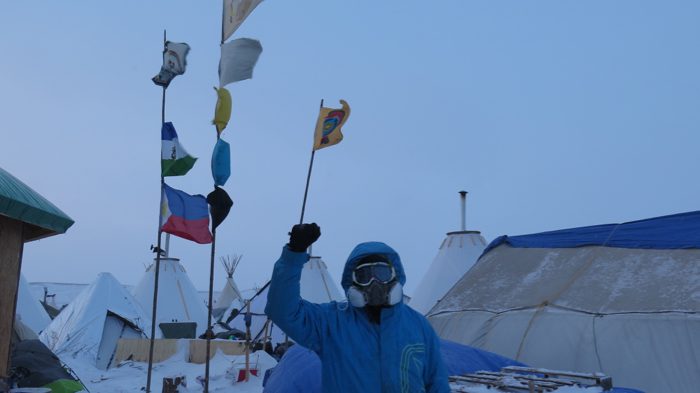
By Tracy L. Barnett and Tami Brunk
For Intercontinental Cry and The Esperanza Project
OCETI SAKOWIN CAMP, N.D.—A winter lull in activities for Water Protectors at Standing Rock is about to come to an end. An executive order confirming the incoming administration’s commitment to forge ahead – not just with the Dakota Access Pipeline, but with the cancelled Keystone XL – has solidified resolve at the encampments, where resisters are calling on reinforcements from society at large. A major confrontation with military-armed police and private security forces now seems inevitable.
Far from making plans to evacuate, however, the 500-600 individuals who remain in the camps at Standing Rock are making plans to move the camp to higher ground in anticipation of spring floods. And some are planning their resistance to Keystone, which passes within a few miles of the Cheyenne Sioux Reservation just three hours to the south.
Meanwhile, IC takes a brief pause to bring you #VoicesFromStandingRock, a collection of interviews that we gathered in a December visit to the snowy plain. These stories shed light on the many-hued wave of humanity that has descended on Standing Rock in recent months – some for a few days, some for a few months and some for the duration.
They also shed light on the significance of Standing Rock, which has become a powerful symbol for Indigenous Peoples and for the embattled climate justice movement. But they are also the powerful personal stories of just a few of the thousands who braved icy roads and faced subzero temperatures in a pilgrimage that is as much spiritual as it is political.
In this series, you will meet people like Theron Begay, a Diné bullfghter who was offered a construction job by DAPL and turned it down – “it’s too cold,” he says now with a laugh – and ended up becoming the construction director for Oceti Sakowin Camp. People like Orlando Avery, a Lakota schoolteacher who quit his job to come stand in front of the women and children and elders who were under attack by law enforcement at the frontlines. People like Mick Waggoner, a roller derby world champion whose Navajo roots were calling her home from overseas. And people like Anthony Aspaas and Julius Tully, who came to help and to find healing for their own wounded souls like thousands of other Native veterans.
These five individuals are just a few of the people you will meet in Intercontinental Cry’s Water Protector Series being launched today. Others will share their stories in these pages in the days and weeks ahead.
Intercontinental Cry is partnering with The Esperanza Project in this series. Other non-indigenous Water Protectors will be featured there. Special thanks to Synde Mass, Rene Livingston. Annabelle Vinois, Dave Meyer and Michelle Nermon for help with transcriptions.
The interviews:
“I’ll always remember the first structure I built for a grandma… She was crying, she was happy. We put in a stove for her. To feel that hug, to feel that emotion she had… that feeling was a bigger payback than any check I ever received.” – Theron Begay
“I found that warrior spirit to take care of people, to be there and to put myself in front of others and be that warrior for them, you know? For the ones who can’t . . .” – Orlando Avery
Mick Waggoner and Bonnie Wykman
“It feels good to know even though [our friends are] not indigenous they know about our struggle and they are donating because they feel connected to it. And if it’s through me, that’s fine – but eventually it’s going to be because they care about their water, and they’re going to start caring about what’s happening in their environment and how it’s being impacted, and that’s the point.”– Mick Waggoner
“I was calm and peaceful. I felt exactly as though I was marching with spirits of those same Native warriors that fought to protect and guarded this very land here.” – Julius Tulley
“We are also ISIS — an ISIS of life. ISIS is Indigenous Standing in Solidarity… one day it just came to me in my dream. We are ISIS. Life givers. We protect the water. Water is the most important thing that sustains life on this planet… And that’s what drove me here.” -Anthony Aspaas (Photo by Bazh Nibah Photography/Facebook_
Anthony Aspaas Bonnie Wykman DAPL indigenous rights Julius Tulley Mick Swagger Mick Waggoner Missouri River Native American rights NoDAPL Orlando Avery pipelines Standing Rock Sioux Tribe Theron Begay treaty rights water




